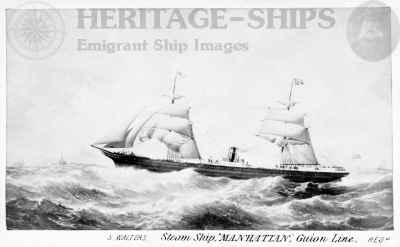The Manhattan was the first steamship built for the Guion Line. Constructed of iron, the Manhattan measured 343 feet in length (335 feet at the keel), with a beam of 42 feet and a depth of 28 feet. She had a gross register tonnage of 2,866 tons and could carry 2,000 tons of cargo and 1,000 tons of coal. She was launched in June 1866 by Palmer & Co. at Jarrow on the River Tyne for the Liverpool and Great Western Steamship Company (Limited), under the management of Messrs. Guion & Co. of Liverpool (Guion Line). Built for transatlantic service, the vessel represented contemporary advancements in marine engineering and ship construction. The Manhattan completed her trial trip on July 14, 1866, achieving a speed of 12 knots. She was equipped with surface-condensing engines built on Samuel Hall’s principle, featuring two 60-inch cylinders with a 3 ft. 6 in. stroke. Steam was provided at 35 lbs per square inch by four boilers heated by sixteen furnaces, offering a heating surface of 6,600 square feet. Steam power also operated the deck machinery, including winches, windlasses, and pumps. She was brig-rigged and capable of sailing under a large spread of canvas if necessary. The hull was subdivided into six watertight compartments. Structural features such as reinforced engine hatchways and a fully enclosed engine house were incorporated in response to previous maritime losses, providing additional protection in heavy seas. She carried eight long lifeboats, each capable of holding 100 people.
She was designed to accommodate up to 1,000 passengers; 72 in saloon class and 800 in steerage; and carried a crew of approximately 80. Steerage passengers were housed on the main deck, which was considered well-ventilated and spacious for its time. The berths were designed to be removable to allow for additional cargo space when needed. The saloon and first-class quarters, located in the aft section, were richly appointed. The central saloon featured 72 berths and was carpeted with fine Brussels carpeting. It also included the captain’s quarters and ladies’ saloons. The berths were luxuriously furnished, with plush velvet couches, mahogany dining tables, rosewood sideboards, and elegant pier glasses. Scarlet velvet covers adorned the seating, and the saloon was illuminated by ornate brass chandeliers. The crew were accommodated in well-ventilated and comfortable berths in the forecastle. Officers and engineers were housed amidships, with more luxurious and private quarters.
Ventilation was ingeniously designed. Two nested tubes extended from the quarterdeck down through the spar and main decks to the orlop deck: the inner tube extracted stale air, while the outer tube supplied fresh air to the decks. This same principle was applied throughout the vessel.
The Manhattan was soon followed by 2 identical sisters, the Chicago and the Minnesota.

Manhattan, Guion Line steamship (old CDV)
Support Norway Heritage: Purchase a copy